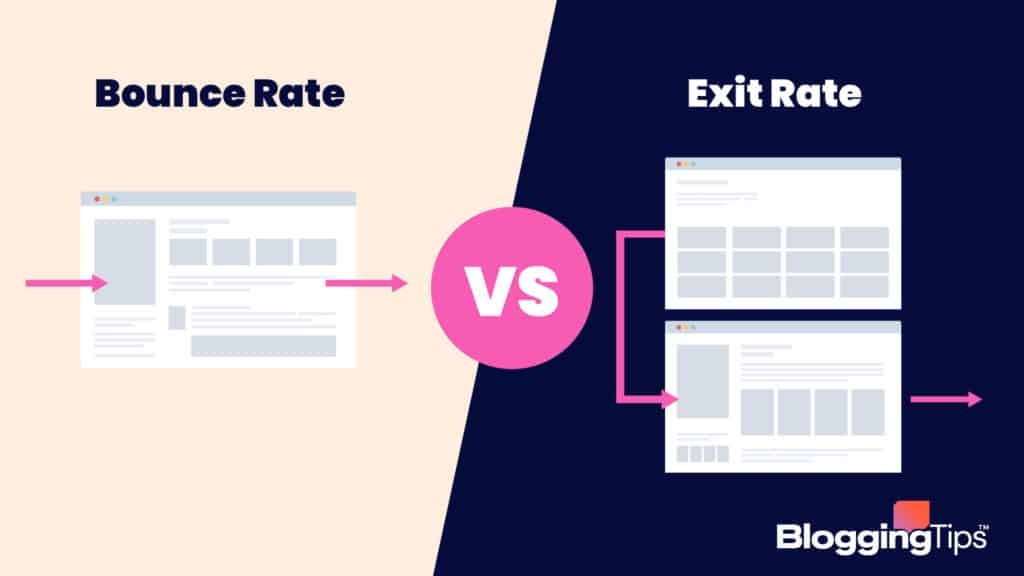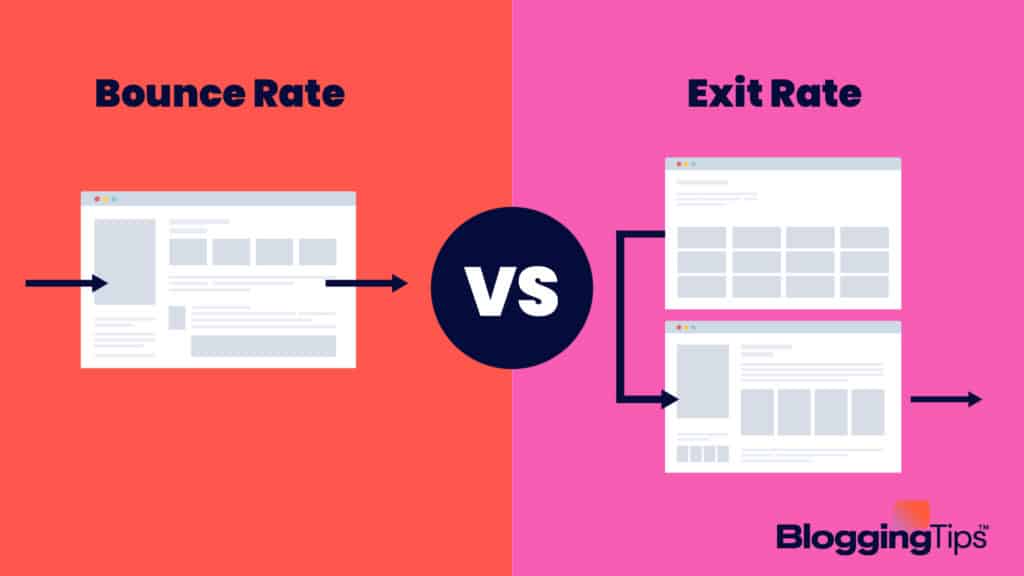
Managing a successful website is challenging, particularly when differentiating between highly interested users and those who take a quick look around and leave.
Your Bounce and Exit rates are one potential indicator, but what do those two terms mean?
How are they different?
Between bounce rate vs. exit rate, which is more important?
Most importantly, how can they help you manage your website?
The following is a summary of each term, what they meant to you and how you can use them in the future to improve your web presence.
Bounce Rate Vs. Exit Rate Overview
Both bounce and exit rates are very fancy terms for very easy-to-understand concepts.
Here is a rundown.
What Is Bounce Rate?
Technically, a bounce rate is a percentage of total visitors that are single-engagement.
Single-engagement means the number of people that stop by your site, either by happenchance or because of search results, but their only action on the site is to leave it.
What Does a High Bounce Rate Indicate?
A bounce rate is one potential indicator of how many visitors did not find your website all that engaging or valuable.
There can be a few reasons why someone might visit and not engage:
- Lack of content usefulness (for them)
- Lack of product usefulness
- Irrelevant or outdated content
- Differences between search results and site relevancy
What Is an Exit Rate?
An exit rate is the number of people that have left your website from a specific page.
An exit rate gets recorded no matter what a visitor did or did not do on that page.
So, for instance, if a website has three pages, the exit rate will show what visitors departed the website from what pages.
What Does an Exit Rate Indicate?
The exit rate of a website shows when visitors find what they want and take a specific action or decide to depart, having done nothing.
Every website visitor eventually leaves but knowing if they left at the product page or the transaction or sales confirmation pages can help you formulate marketing, sales, and product strategies.
Bounce Rate vs. Exit Rate: What’s the Difference?
The difference between a bounce rate and an exit rate is simple:
A bounce rate indicates a visitor that came on the site and left without taking any other action.
In and of itself, a high bounce rate suggests nothing of significance.
It would be odd if your website had no bounce rate because no company has a 100 percent conversion rate from website visitors.
Even news aggregate sites have people who only look at headlines and leave.
An exit rate indicates the page a visitor to your website left.
It will include those who took off after just accessing the site and those who took an additional step to visit another page.
If your website is linear, it will show the pages a user visited and give you an idea of what got them to a certain point in their engagement with your site.
Which Metric Is More Important?
Neither a bounce nor an exit rate is “more important” because they serve different functions.
Both might indicate a problem with your website, content, or SEO setup, but neither is superior to the other. The difference is in how each gets used.
A bounce rate is an excellent way to assess how many visitors to your website are stopping at one page and leaving.
An exit rate indicates that visitors can navigate your site and do so but leave at a certain point.
Bounce Rate vs. Exit Rate: How Are They Calculated?
Both bounce and exit rates are calculated using a straightforward formula.
Here both are.
How Is Bounce Rate Calculated?
A bounce rate uses the following formula:
R = Total One Page Visits / Total Visits to the website.
For example, if a website has 100 visitors and 25 leave after only seeing one page, the bounce rate of that website would be .25.
How Is the Exit Rate Calculated?
An exit rate is calculated by dividing the total number of exits by the total number of views for one page.
So if a page has 100 exits and 150 total views, its exit rate would be .66.
An effective way to think about this is that all bounces are exits, but not all exits are bounces.
Bounce Rate vs. Exit Rate: How Do They Impact SEO?
While bounce and exit rates can indicate an issue with everything from SEO to technical difficulties, one can directly affect your SEO and search engine results.

- Bounce Rate SEO Impact: A bounce rate can negatively influence search engine rankings and thus impact the effectiveness of SEO. When a user bounces from your link page back to search engine results, it is called “pogo-sticking.” Pogo-sticking can cause Google to adjust the results on pages for that specific query to rank sites that users spend time on rank higher.
- Exit Rate SEO Impact: The exit rate has no impact on SEO.
Why Does It Help to Measure Bounce Rates and Exit Rates in Marketing?
Both measurements can identify issues with a website or page.
If a website has a high bounce rate, one possibility is that its SEO is using the wrong keywords or phrases.
If a particular page on a website has a lot of views, but people leave, it indicates that the page might not be as effective as marketers think.
The exception to both are sites that have a single function or page.
How To Find Your Bounce and Exit Rate
To find your bounce rate, you divide your total one-page exits by the total number of visitors.
To find your exit rate, divide your total number of exits for a page by the total number of views.
What Values Should Bounce and Exit Rates Have?
Bounce and exit rates vary based on a specific website.
Here are some industry averages.
- What Is a Good Bounce Rate? A reasonable bounce rate is 20 to 40%. An ideal bounce rate is under 20%.
- Is a Bounce Rate of 45% Good? A 45% bounce rate is average.
- What Is a Good Exit Rate? A reasonable exit rate is harder to pin down. A better way to look at it is if you have a particular page with a high exit rate (over 50%) unless it is your confirmation page. It is an issue if people leave a specific page before making a purchase.
What Might Increase Bounce and Exit Rates?
Either could be a sign of operational or SEO problems.
Operational problems would include:
- Pages loaded slow
- The site kicked them out
- Odd formatting that makes a page hard to read
- External processes like payments do not work
Marketing and SEO problems could include:
- Search criteria that do not match what the website offers
- Overly broad keyword engagement
- Content and product issues
- Overly complicated or uninformative pages
A user might decide to leave a page in any of these instances.
Still, if a user visits a site and leaves without looking at other pages, the causation usually falls into one of these categories.
How To Reduce Your Bounce and Exit Rate

The best way to reduce either or both is to use a customer survey.
The key is to be succinct.
Placing an on-site survey or prompting people to take a survey when they navigate away from the website will let them tell you exactly why they bounced or exited when they did.
Ask no more than three multiple choice questions and have a comments section if they elect to use it.
The following are good questions:
- Did you find what you are looking for?
- Did the search engine results match what you were looking for?
- What could make your visit better?
The comment section should ask them how they would change your site to make it more responsive to your needs.
Letting them comment is an essential step because it engages the user further.
In addition, several tools are available for analyzing the behavior of visitors to your site.
A heat map is one option.
Another is to record user behavior on the site to see where they leave.
Starting with a survey, however, guarantees you direct feedback with at least a portion of those that bounce and
Final Thoughts
Bounce and exit rates are great measurements of search engine results to understand why a person exited a site.
Both, however, must be taken with a grain of salt.
Sometimes, a higher rating does not indicate any problem on your end.
Understanding why your rates might be high can help you create a more effective website.
The takeaway is that you must track your bounce and exit rates, or you will not know if you have an issue or why.
While neither is a definitive answer to why someone might leave a site prematurely, a tool like a survey can get them to pinpoint the reason for you.
If you do not check your bounce and exit rates, you might never realize you have an issue.


Responses